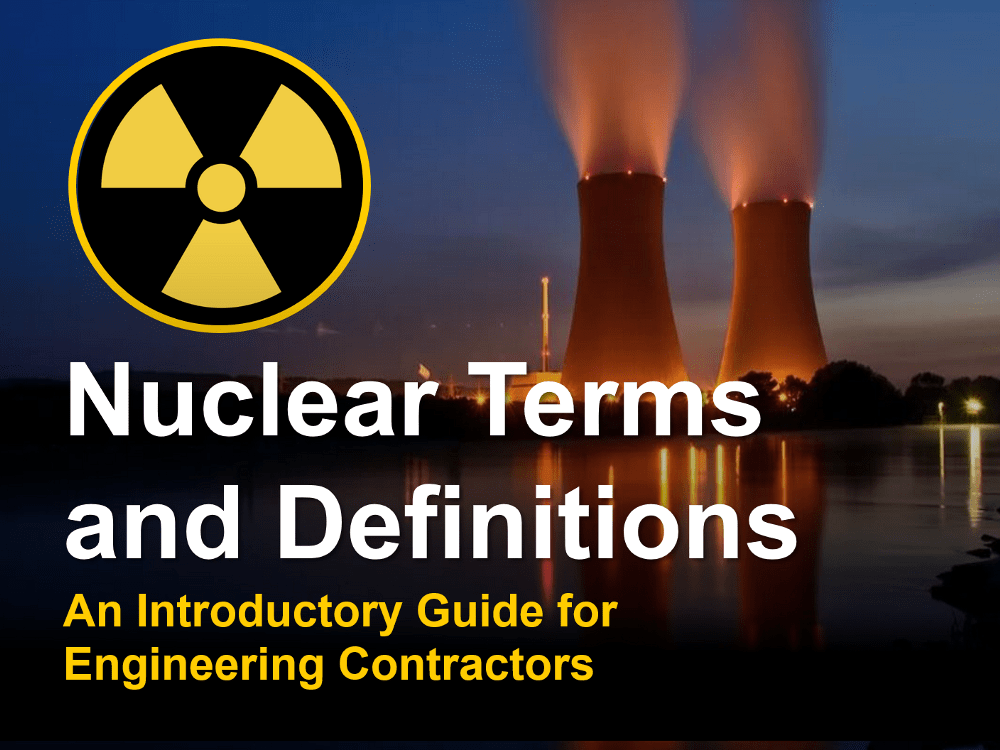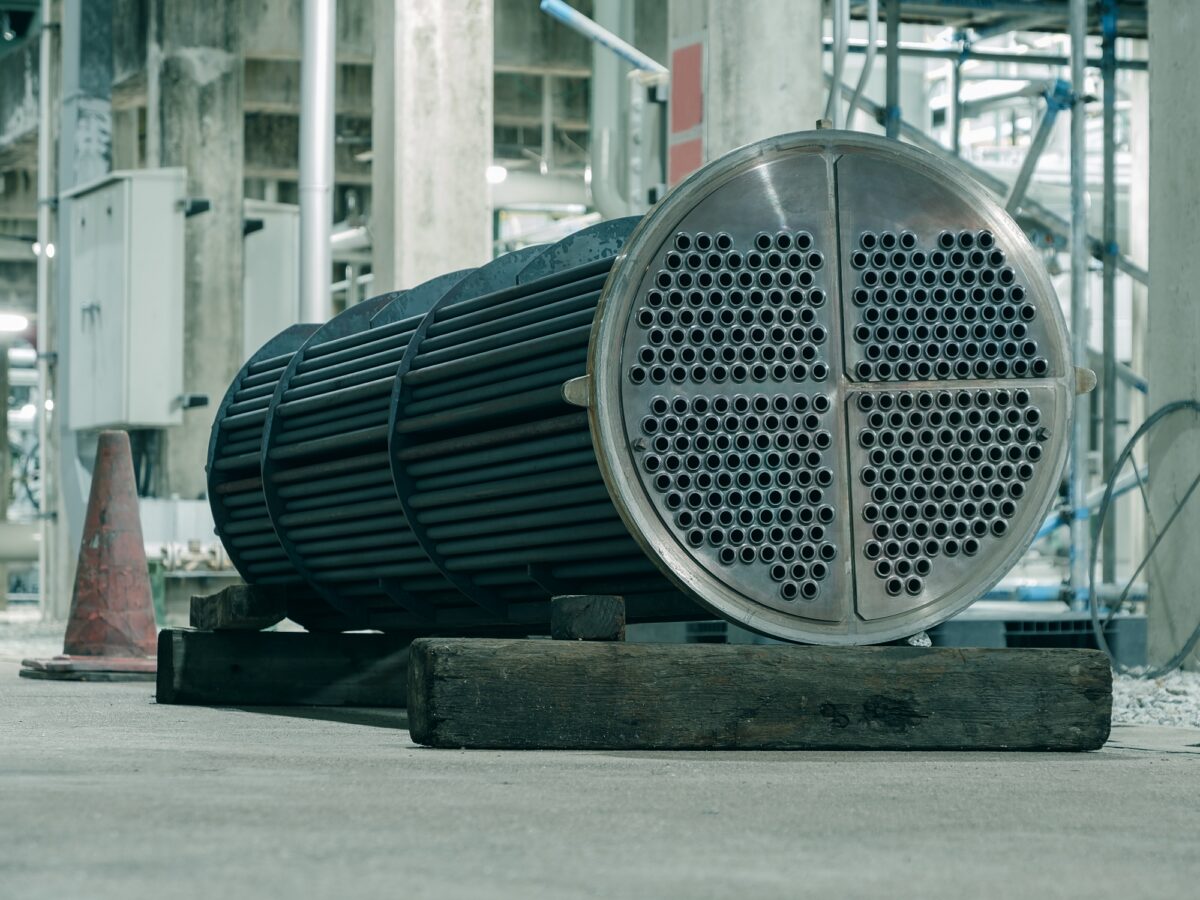Nuclear Terms and Definitions

November 30, 2021
0
Many nuclear terms and definitions heard onsite can be confusing for anyone new to the sector – especially for new employees or contractors involved in this type of work for the first time.
For those who do win the contracts, there’s plenty of opportunities for maintenance work, decommissioning, heavy lifting, and on-site machining. Aside from the workings of a nuclear reactor, the fundamentals are pretty much the same as fossil fuel power stations. There are steam turbines to be maintained, pipe and flange joints to secure, and heavy lifting jobs to be done.
So, for those of you unfamiliar with the nuclear power sector and thirst for knowledge, we’ve put together a glossary of some of the more common nuclear terms and definitions – and if you want to know more, see the websites listed at the end of the article.
Nuclear Terms and Definitions: An Introductory Guide for Engineering Contractors
ABWR
The Advanced Boiling Water Reactor is the evolution of the BWR (Boiling Water Reactor) design. The ABWR is a third-generation reactor developed by GE Hitachi Nuclear Energy. The ABWR is currently licensed in Japan, Taiwan, and the United States of America.
Acute Exposure
Short, intensive exposure to radiation or to toxic substances that can result in severe biological harm or death.
AGR
Advanced Gas Cooled Reactor: A term used for the second generation of British Power Reactors. The fuel used is slightly enriched uranium oxide clad in stainless steel tubes. The coolant is carbon dioxide, and the moderator is graphite.
Alpha Particle Radiation
Of the nuclear terms of the three radiation types (Alpha, Beta, and Gamma), Alpha is the radiation with the lowest potential for penetrating materials. It can be stopped by a sheet of paper and is only dangerous for living creatures if the particles are inhaled, consumed with food, or if they enter wounds.
Atom
An atom is the smallest particle of an element. It consists of a central core, (nucleus), containing protons and neutrons, and electrons revolving around the nucleus.
Auxiliary Feedwater
A backup water supply used to supply water to steam generators during reactor startup, shutdown, and during accident conditions.
Background Radiation
This is radiation which we are all exposed to. It comes from cosmic and geological sources. Typical radiation examples including naturally occurring radioactive materials are Radon and Thorium, both which naturally exist in small quantities within granite.
Becquerel (Bq)
The unit of radioactive decay is equal to 1 disintegration per second. Named after Henri Becquerel, who shared a Nobel Prize with Pierre and Marie Curie for their work in discovering radioactivity.
Beta Particle Radiation
Another one of the nuclear terms of the three types of radiation. Beta particles are lighter than alpha particles, and generally have a greater ability to penetrate other materials. They can travel a few feet in the air and can penetrate the skin, but a thin sheet of metal or plastic or a block of wood will stop them.
Boiling Water Reactor (BWR)
A reactor design where water is allowed to boil inside the core. The steam produced is used to drive a turbine and electrical generator.
Breeder Reactor
A reactor designed to produce more fuel (fissile material) than it consumes.
CCA
Contamination Control Area.
CCR
Central Control Room.
Chernobyl Incident
A nuclear accident that occurred on 26 April 1986 at the Chernobyl Nuclear Power Plant in Ukraine. An explosion and fire released large quantities of radioactive contamination into the atmosphere, which spread over much of Western USSR and Europe. It is considered the worst nuclear plant accident. Today, the large evacuation zone around the site remains largely uninhabited.
Controlled Area
An area outside a restricted zone but within the site boundary of a nuclear facility.
Condenser
Used to cool exhaust steam from a turbine below the boiling point – so it can be returned to the heat source as water.
Control Rods
These absorb neutrons so that the chain reaction in a reactor core may be slowed or stopped by inserting them further or accelerated by withdrawing them.
Curie (Ci)
One of the nuclear terms used to measure the intensity of radioactivity in a material.
CWS
Cooling Water System.
Decay (Radioactive)
The decrease in the radioactive nature of any material over time.
Dose
A dose is a measure of a radiation exposure using the international system of units (SI system) “gray” (Gy) and “sievert” (Sv).
ECCS
An Emergency Core Cooling System – which comprises a series of systems designed to safely shut down a nuclear reactor during accident conditions.
Electron
A very small negatively charged particle orbiting the nucleus of an atom. It is a stable subatomic particle found in all atoms and acts as the primary carrier of electricity in solids.
Entomb
This is a method of decommissioning where radioactive material is encased within a structurally long-lived material, such as concrete.
ESBWR
Economic Simplified Boiling Water Reactor. An evolution of the Boiling Water Reactor (‘BWR’) design, using passive circulation for normal operations and simplified, passive safety systems. Intended to bring simplicity, greater safety, improved economics, and operational flexibility.
Fast Breeder
A type of nuclear reactor using fast neutrons to generate more nuclear fuels than they consume while generating power. These dramatically enhance the efficiency of the use of resources.
Feedwater
Water used to remove heat from a reactor and produce steam to drive the turbine generators.
Film Badge
Used for the measurement of radiation exposure for personnel monitoring purposes.
Fuel Reprocessing
The method of processing reactor fuel to separate reusable fissionable material from waste material.
Fission
The process occurring inside a power plant’s nuclear reactor. It is the release of energy as heavy element atoms are split up into smaller atoms – producing free neutrons and large amounts of energy.
The second most serious civil nuclear accident (after Chernobyl). This was a result of the Great East Japan earthquake and the resulting tsunami in March 2011.
Fusion
Nuclear fusion is a reaction in which two or more atomic nuclei are combined to form one or more different atomic nuclei and subatomic particles (neutrons or protons). Fusion is the process that powers active stars where large amounts of energy are released. Research is underway to try and create this process which if successful, will provide an abundant supply of energy. See more on the ITER website
ESWS
Essential Service Water System. This circulates the water that cools the plant’s heat exchangers and other components, before dissipating the heat into the environment. The water is often drawn from an adjacent river, the sea, or other large body of water.
Gamma Radiation
Another of the nuclear terms for one of the three radiation types. Gamma rays are highly energetic, short-wave electromagnetic radiation emitted from the nucleus of an atom. They are extremely penetrative and are the most dangerous type of radiation. They are weakened or stopped by materials of high density such as lead.
Gas-Cooled Reactor
Broad / generic expression describing a nuclear reactor where gas is used as the coolant.
GDF
Geological Disposal Facility: A long-term nuclear waste management option involving the disposal of waste in an engineered underground facility. The principle is that the geology provides a barrier against the escape of radioactivity and the depth protects the waste from disturbances at the surface.
Geiger Counter
A detection instrument used to detect particles of ionizing radiation – alpha particles, beta particles or gamma radiation. Named after Hans Geiger (1882-1945).
GW
Gigawatt. One billion Watts.
Half-life
The time taken for the radioactivity of a specified isotope to fall to half its original value.
Heat Exchanger
A device that transfers heat from one system to another without the physical transfer of any matter.
HEP
Human Error Probability. A term used in safety engineering.
HLW
High-level waste.
ILW
Intermediate Level Waste
Ion
An atom that has too many or too few electrons – causing it to have an electrical charge.
Isotope
Isotopes of an element have the same atomic number (same number of protons in their nuclei) but different atomic weights (different number of neutrons in their nuclei). Uranium-238 and uranium-235 are isotopes of uranium.
ITER
This is an international research project that aims to demonstrate the possibility of producing commercial energy from nuclear fusion. See more on the ITER website
Joule
The SI unit of energy. The release of one Joule per second is one Watt.
Kilowatt
A measure of one thousand watts of electrical power.
Lethal Dose
This is an ionizing radiation dose leading to the death of the irradiated individual due to acute radiation injuries. LD1 is the dose leading to a mortality of 1% of the irradiated persons, LD99 is lethal for all (99%) persons irradiated.
LLW
Low-Level Waste.
MAGNOX
First-generation UK reactor, so-called because of the non-oxidizing magnesium alloy cladding used to contain uranium fuel rods.
Megawatt (MW)
A unit of power, one million watts. A large power plant such as the Palo Verde in Arizona generates 3,872 megawatts from its 3 reactors.
Molecule
The smallest portion of a substance that can exist by itself and retain the properties of the substance. Molecules consist of multiple atoms and a particular molecule has a specific number of atoms arranged in a specific way.
MOX Fuel
Mixed Oxide Fuel: A blend of oxides of plutonium and natural uranium, reprocessed uranium, or depleted uranium.
NDA
Nuclear Decommissioning Authority (in the United Kingdom).
Neutron
An uncharged elementary particle found in the nucleus of every atom – except hydrogen.
NPP
Nuclear Power Plant.
Nuclear Island
The part of a nuclear power plant incorporating all equipment, systems, installation and control and other relevant hardware installed within the reactor and reactor auxiliary buildings.
Nucleus
The core of an atom, occupying little of the volume but containing most of the mass, and bearing positive electric charge. It consists of protons and neutrons.
PHWR
This nuclear term is an abbreviation of ‘Pressurized Heavy Water Reactor’ – A reactor type that uses natural uranium as its fuel and heavy water as the coolant. The Canadian CANDU design is the most common example.
Oxide fuels
Enriched or natural uranium in the form of the oxide UO2, used in many types of reactors.
Pressurized water reactor (PWR)
This type of reactor makes up the large majority of the world’s nuclear power plants (exceptions being the United Kingdom, Japan, and Canada). They are one of three types of light water reactors (LWR), the other types being boiling water reactors (BWRs) and supercritical water reactors (SCWRs).
Plutonium
A heavy, radioactive, manmade metallic element with atomic number 94. Plutonium has been used to make nuclear weapons and in nuclear power plants to produce electricity. It is also used as a portable energy supply in space probes and other space vehicles.
POCO
Post Operational Clean Out: The first stage in preparing the plant for care and maintenance after operations have ceased.
Pond
As the name suggests, this nuclear term describes a Water storage facility for encased nuclear waste and fuel units awaiting reprocessing.
Proton
A stable subatomic particle occurring in all atomic nuclei, with a positive electric charge equal in magnitude to that of an electron.
PWR
Pressurized Water Reactor: A reactor using primary coolant maintained under such a pressure that no bulk boiling occurs.
Reactor
The reactor is the heart of a nuclear power plant. It is where nuclear fission is sustained and controlled in a self-supporting nuclear reaction.
Radon
A heavy radioactive gas given off by rocks containing radium or thorium. These rocks have existed since the formation of Earth’s crust.
Repository
Long-term radioactive waste storage facility.
Reprocessing
Recycling of spent nuclear fuel into reusable uranium, plutonium, and fission products.
SCWR
Super Critical Water Reactors are high-temperature, high-pressure, light-water-cooled reactors that operate above the thermodynamic critical point of water (374°C, 22.1 MPa).
Sv
The Sievert is a measurement unit of radiation dose to living tissue.
TW
Terawatt, one trillion Watts.
Uranium
The fuel used in a nuclear reactor. It is the heaviest known naturally occurring element, consisting of two isotopes: uranium-235, which undergoes fission, and uranium-238 which does not.
Vitrification
A process used to solidify concentrated solutions of fission radioactive waste by mixing them with a glass matrix at high temperature. Glass discs/ blocks are placed into long-term storage where they are air-cooled while the radioactivity decays.
VLLW
Very low-level waste.
Waste
High-level waste (HLW) is highly radioactive material arising from nuclear fission. It requires very careful handling, storage, and disposal. Intermediate-level waste (ILW) is sufficiently radioactive to require shielding and is disposed of in engineered facilities underground. Low-level waste (LLW) is mildly radioactive material usually disposed of by incineration and burial.
Wet Storage
Storage of spent fuel in a pond filled with water.
X-ray
X-rays are electromagnetic waves and ionizing, virtually identical to gamma rays, but not nuclear in origin.
Yellowcake
Ammonium diuranate, the penultimate uranium compound in U3O8 production, but the form in which mine product, was sold until about 1970.
Zircaloy
Zirconium alloy used as a tube to contain uranium oxide fuel pellets in a fuel rod (part of a reactor fuel assembly).
Recommended Industrial Tools for Nuclear Power Plants
Sources and Further Information
Burgess Salmon (PDF Document)
See More Articles Like This
Wind Power Terms and Definitions
Offshore Decommissioning Terms



